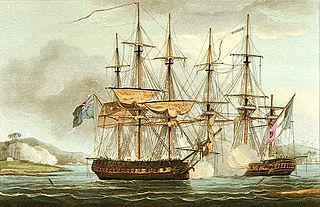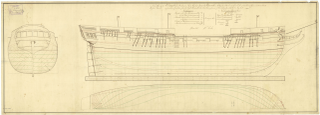
The Gunboat War was a naval conflict between Denmark–Norway and Great Britain supported by Sweden during the Napoleonic Wars. The war's name is derived from the Danish tactic of employing small gunboats against the materially superior Royal Navy. In Scandinavia it is seen as the later stage of the English Wars, whose commencement is accounted as the First Battle of Copenhagen in 1801.
HMS Staunch was a Royal Navy 12-gun Archer-class gun-brig, built by Benjamin Tanner and launched in 1804 at Dartmouth, Devon. She served in the Indian Ocean and participated in the action of 18 September 1810 before she foundered with the loss of all hands in 1811.

Chiffonne was a 38-gun Heureuse-class frigate of the French Navy. She was built at Nantes and launched in 1799. The British Royal Navy captured her in 1801. In 1809 she participated in a campaign against pirates in the Persian Gulf. She was sold for breaking up in 1814.

HMS Calcutta was the East Indiaman Warley, converted to a Royal Navy 56-gun fourth rate. This ship of the line served for a time as an armed transport. She also transported convicts to Australia in a voyage that became a circumnavigation of the world. The French 74-gun Magnanime captured Calcutta in 1805. In 1809, after she ran aground during the Battle of the Basque Roads and her crew had abandoned her, a British boarding party burned her.

HMS Leveret was a Cruizer-class brig-sloop built at Dover, England, and launched in 1806. She was wrecked in 1807.

HMS Ferret was a Royal Navy Cruizer-class brig-sloop built by Benjamin Tanner at Dartmouth and launched in 1806, 19 months late. She served on the Jamaica, Halifax, and Leith stations during which time she took three privateers as prizes before she was wrecked in 1813.

HMS Magnet was a Cruizer-class brig-sloop built at Robert Guillaume’s yard at Northam and launched in 1807. She served in the Baltic, where she took two prizes, one an armed privateer, before wrecking in 1809.
HMS Capelin was a Royal Navy Ballahoo-class schooner carrying four 12-pounder carronades and a crew of 20. The prime contractor for the vessel was Goodrich & Co., in Bermuda, and she was launched in 1804. Like many of her class and the related Cuckoo-class schooners, she succumbed to the perils of the sea relatively early in her career.
HMS Herring was a Royal Navy Ballahoo-class schooner of four 12-pounder carronades and a crew of 20. The prime contractor for the vessel was Goodrich & Co., in Bermuda, and she was launched in 1804. She spent most of her career in North American waters though she did spend two years sailing between Britain and Spain before returning to North America where she foundered in 1813.

HMS Haddock was a Royal Navy schooner of four 12-pounder carronades and a crew of 20. The prime contractor for the vessel was Goodrich & Co., in Bermuda, and she was launched in 1805.
On Thursday 21st inst launched off the stocks at Mr Isaac Skinner's shipyard his Majesty's Schooner "Haddock". The above schooner is said to be the completest vessel ever built in Bermuda
HMS Widgeon was a Royal Navy Cuckoo-class schooner built by William Wheaton at Brixham and launched in 1806. Like many of her class and the related Ballahoo-class schooners, she succumbed to the perils of the sea relatively early in her career.
HMS Fama was the Danish brig Fama, of fourteen guns, built in 1802, that the British captured in 1808. She was wrecked at the end of the year.
HMS Merlin was launched in 1801 in South Shields as the collier Hercules. In July 1803, with the resumption of war with France, the Admiralty purchased her. She was one of about 20 such vessels that the navy would then employ primarily for convoy escort duties. She served on active duty until 1810, capturing one small privateer. She then served as a receiving ship until 1836 when the navy sold her for breaking up.

The French schooner Impériale was a 3-gun mercantile schooner-aviso of the French Navy commissioned at Guadeloupe on 23 September 1805. The Royal Navy captured her on 24 May 1806 and named her HMS Vigilant. The Navy renamed her HMS Subtle on 20 November 1806. She wrecked at Bermuda on 20 October 1807.
HMS Prospero was the mercantile Albion, launched at South Shields in 1800. The British Royal Navy purchased her in 1803 and converted her to a bomb vessel. She foundered in 1807 with the loss of almost her entire crew.
Rosina was launched at Hull in 1803. She almost immediately became a hired armed ship for the British Royal Navy for about a year. After she returned to her owners she became a West Indiaman and then a transport. She was last listed in 1818.

The Thames-class frigate was a 32-gun fifth-rate frigate class of eight ships of the Royal Navy based on the Richmond-class frigate designed by William Bately. The ships were ordered to the older design, which was of a smaller type of ship compared to more modern designs, so that they could be built quickly and cheaply in time to assist in defending against Napoleon's expected invasion of Britain. The class received several design changes to the Richmond class, being built of fir instead of oak, with these changes making the class generally slower and less weatherly than their predecessors, especially when in heavy weather conditions. The first two ships of the class, Pallas and Circe, were ordered on 16 March 1804 with two more ordered on 1 May and the final four on 12 July. The final ship of the class, Medea, was cancelled on 22 October before construction could begin but the other seven ships of the class were commissioned between 1804 and 1806.

HMS Wolf was a Merlin-class sloop launched at Dartmouth in 1804. She captured or destroyed four small Spanish or French privateers before she was wrecked on 4 September 1806 in the Bahamas.
HMS Sparkler was launched in 1804 at Brightlingsea. Lieutenant James S.A.Dennis commissioned her in August 1804 for the North Sea.
HMS Fly was launched in 1805. In 1807 she participated in one major naval campaign. She was wrecked on 28 February 1812 at Anholt Island in the Kattegat.








